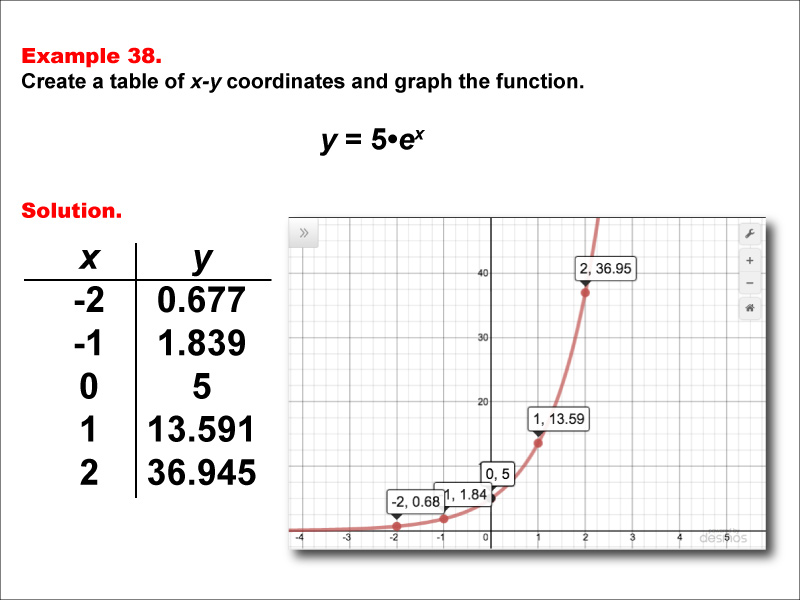
Display Title
Math Example--Exponential Concepts--Exponential Functions in Tabular and Graph Form: Example 38
Display Title
Math Example--Exponential Concepts--Exponential Functions in Tabular and Graph Form: Example 38

Topic
Exponential Functions
Description
This math example illustrates the exponential function y = 5 * ex through a table of x-y coordinates and a corresponding graph. The table lists values for x ranging from -2 to 2, showing how the function's output changes as x increases. The graph provides a visual representation of this scaled natural exponential function, emphasizing its characteristic shape and behavior.
Exponential functions, especially those involving the natural base e and a coefficient, are crucial in mathematics and have wide-ranging applications in fields such as finance, physics, and biology. This collection of examples aids in teaching the topic by presenting students with various representations of exponential functions, allowing them to observe how different parameters affect the function's behavior. By examining both tabular and graphical forms of scaled natural exponential functions, students can develop a deeper understanding of how coefficients impact the graph's y-intercept and overall scale.
The importance of studying multiple worked-out examples cannot be overstated when learning about exponential functions, particularly those with coefficients. Each example in this set highlights a different aspect of exponential functions, helping students recognize patterns and understand how changes in the coefficient impact the function's graph and values. This variety of examples reinforces the concept and helps students build a more intuitive grasp of exponential behavior, preparing them to tackle more complex problems and real-world applications involving scaled growth and decay processes.
Teacher Script: "Let's examine the function y = 5 * ex. Notice how this graph is similar to our previous natural exponential function, but it's been scaled up. The y-intercept is now at (0, 5) instead of (0, 1). How does this scaling affect the rate of growth compared to y = ex? Can you predict what the graph of y = 0.5 * ex might look like based on this example?"
For a complete collection of math examples related to Exponential Functions click on this link: Math Examples: Exponential Functions Collection.
| Common Core Standards | CCSS.MATH.CONTENT.HSF.IF.C.7.E, CCSS.Math.CONTENT.HSF.LE.A.2, CCSS.MATH.CONTENT.HSF.LE.B.5 |
|---|---|
| Grade Range | 9 - 12 |
| Curriculum Nodes |
Algebra • Exponential and Logarithmic Functions • Graphs of Exponential and Logarithmic Functions |
| Copyright Year | 2015 |
| Keywords | function, graphs of exponential functions, exponential function tables |